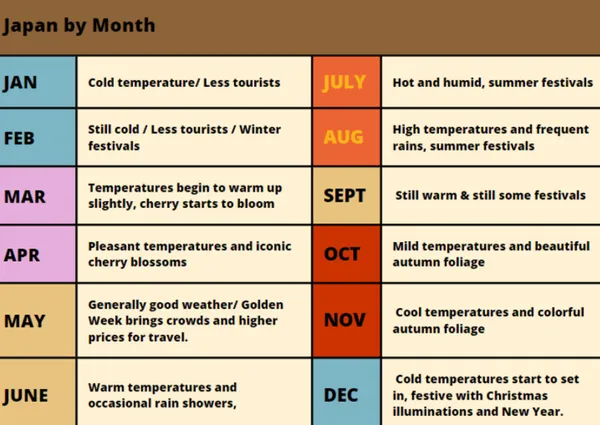5. SEASONS & WHEN TO GO
Don't forget & What to pack & When to go ?
CLIMATE IN JAPAN
Japan lies in the northern hemisphere, with the majority of the island chain belonging to temperate zones. However, because of the complex geography and long north-south range, the climate differs broadly by region, even during the same season.
Hokkaidō
The main northern island, distinguished by frigid winters, cool summers, and no rainy season.
Pacific Ocean Side
Summers are hot and muggy, while winters are sunny and dry.
Japan Sea Side
The seasonal winds blowing in from Siberia are moistened by the warm currents of the Japan Sea. These winds then collide with the mountains in central Honshū, making this one of the heaviest snowfall regions in the world.
Central Highlands
The region focused on the mountains in central Honshū and the basin formed between these mountains. Characterized by wide temperature fluctuations throughout the year and during single days.
Seto Inland Sea Coast
This region is sandwiched between mountains on the north and south, minimizing the impact of seasonal winds, and ensuring sunny and dry weather throughout the year.
San’in Region
The region most strongly hit by the impact of seasonal winds from Siberia after the Japan sea side of Japan. The weather in winter is perennially cloudy, while summers are hot.
South Sea Region
A region distinguished by warm and rainy weather around the year, a long rainy season, and frequent typhoons.
Southwestern Islands
A region with a warm and rainy subtropical climate. The warmest area in Japan, these islands are known for their coconut and mangrove trees
WINTER
Perfect for skiing in places like Saharo, Furano, and Rusutsu, and experiencing Japan under snow, along with hot springs (onsen) and year-end festivities.
HARU-ICHIBAN (Mid Jan. through Mar.)
In winter, chilly winds blow from the northwest, while in summer, hot and muggy winds come from the southeast. In the spring and autumn, these seasonal winds (also known as "monsoons") fluctuate widely. Haru-Ichiban refers to the first strong southeast wind of the year, which blows as the season shifts from winter to spring.
The haru-ichiban season in Japan is also distinguished by the blooming of plum and camellia blossoms.
In winter, the powerful Siberian air mass gradually weakens, with low-pressure fronts finally reach Japan. Around that time, strong and warm southeast winds serve to carry in these low-pressure masses. These winds are known as haru-ichiban, and the sharp temperature rise often triggers avalanches in heavy snowfall regions.
SPRING
Pleasant temperatures and cherry blossoms in April and May make it peak tourist season, despite crowds at festivals like Takayama Spring Festival.
SAKURA ZENSEN (Apr.)
To the Japanese, the blooming of the cherry blossoms signals the end of another long winter, and the arrival of spring. The "cherry blossom front" refers to a theoretical line connecting the first blooming of these blossoms from region to region. The front travels north from Okinawa to Hokkaidō, providing a barometer of the official arrival of spring from late March to mid-May.
Hanami (Flower-viewing)
Around the time that cherry blossoms come into full bloom, picnic-like parties are held under the trees to view the flowers. This custom is known as hanami (flower viewing). In past ages, this custom was an important part of court etiquette; recently, however, it has come to be utilized as one of the limited opportunities to hold outdoor drinking parties.
SUMMER
High temperatures and regular rains, ideal for climbing Mount Fuji and attending cultural events (matsuri)
TSUYU (Mid Jun. to mid-Jul.)
With the exception of Hokkaidō, rainy weather continues throughout Japan for about one month from mid-June. This phenomenon is caused by the collision above the island chain of cold winds blowing from the Okhotsk Sea and warm winds from the South Pacific, generating rain clouds. When the ensuing rainy season comes to an end, summer has truly arrived.
TYPHOONS
Late August through September is the typhoon season in Japan. With rice crops generally ripening in September, typhoons have been one of the greatest threats to the Japanese lifestyle since ancient times.
AUTUMN
Optimal weather with mild temperatures and vibrant foliage known as koyo marks the end of peak tourist season.
AUTUMN COLORS (Oct.)
September is known for the kisame; zensei, early and the number of rainy days increase. This month is known as the rainy season (tsuyu) in autumn, thereby marking the arrival of the most pleasant season of the year in Japan.
Famous areas for viewing the changing of leaves in autumn include the area around the temples of Kyoto, the area of Arashiyama in Kyoto, and the area of Nikko in Tochigi Prefecture, and the areas known for their beautiful colors are visited by considerable crowds.
This is by far the most pleasant season during the travel of Japan, and the areas known for their beautiful colors are visited by considerable crowds.
Möchte mehr sehen?
Ich habe kuratiert erstellt Karten,Reiserouten und mehr für Reisende, die wie ich reisen möchten.
Suchen Sie nach Unternehmungen?
In meinem Reiseführer finden Sie die besten kostenlosen Aktivitäten sowie Reiserouten und Reisetipps, um Ihre Reise unvergesslich zu machen.


